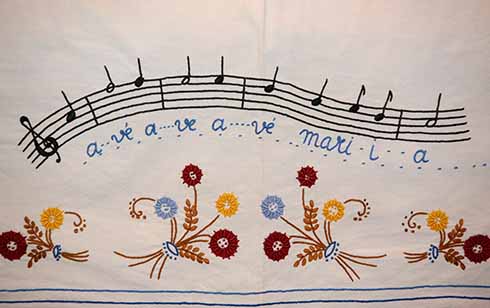 In her self-effacement, Mary exalted God. Similarly, music does not demand attention for itself but rather acts as a guide.
In her self-effacement, Mary exalted God. Similarly, music does not demand attention for itself but rather acts as a guide.
Every New Year begins with the solemnity of Mary the Mother of God (1 January). Now that we’ve left the Christmas Season and begun Lent, what better way to start our devotional meditation by considering the musical importance of this humble peasant girl of Nazareth.
That her great song of praise, the Magnificat (Luke 1:46–55) is likely the oldest Christian hymn is no accident: a self-effacing song of praise echoing the human longing for mercy for the poor and lowly in a world that often forgets them, and daring even to call forth that blessed fulfilment where ‘all generations will call me blessed’. The first musical fulfilment of this prophecy is found in the prayer-hymn Sub Tuum Praesidium from the fourth century,
We turn to you for protection, Holy Mother of God.
Listen to our prayers and help us in our needs.
Save us from every danger, glorious and blessed Virgin.
MARIAN HYMNS
Of course, Marian hymns became a significant part of Christian liturgy and devotion in the Catholic and Orthodox churches (and even in Anglican and Lutheran churches). For example, the Eastern Theotokian (hymn to the Virgin) has been used since the early church in daily prayer and later as part of the liturgy, even as a form of catechesis, a bulwark against heresy with its frequent scriptural emphasis on the Incarnation. The Ave Maria (Hail Mary) which has received many musical incarnations (Schubert, Gounod, and Elgar to name a few) will follow suit, becoming a succinct credo of orthodox Christology, affirming Christ as both fully God and fully man, the ‘fruit of thy womb’ and the son of the ‘mother of God’.
Popular hymns such as Ave Maria Stella became part of the Liturgy of the Hours by the eighth century and inspired many later hymns. The Marian antiphons (also called votive antiphony or priestly hymns) are part of the repertoire of Gregorian chant that, while also referring to more ancient ones, came to refer mostly to four specific chants that increased in prominence from the 13th century. These antiphons came to mark the different liturgical seasons: Alma Redemptoris Mater (Advent); Ave Regina Caelorum (from the feast of The Presentation to Holy Saturday); Regina Caeli (Easter); and Salve Regina (Ordinary Time).
There are an estimated 15,000 Marian hymns most of which were originally written in Latin and thought to be Christmas hymns (that is, in praise of the Incarnation). Other renown Marian hymns include Dante’s prayer from Paradiso, Canto 33, and the hymn Stabat Mater Dolorosa by the Franciscan Jacopone da Todi (this latter received a particularly moving musical setting by the composer Pergolesi).
MUSICAL INSPIRATION
Given the Church’s great influence on the development of Western music, it is no surprise that Mary has provided musical inspiration for some of the great composers. Besides those already mentioned we could add Palestrina, Luis de Victoria, Josquin des Prés, Mozart, Haydn, Verdi, Stravinsky, and Gorecki. There are many more (the famous Let it Be by the Beatles deserves mention here also).
But the question still remains: why should this girl from first-century Palestine exert such influence on music for two millennia? The answer may be found in her own song with which we began, evincing a poignant connection between the Virgin Mary and music. The Magnificat is the song of one who directs attention away from herself to exalt another, namely, the God who alone can vindicate the poor and lowly whose company she claims.
The audacious humility of her who by faith, said ‘be it done unto me according to your word’ (Luke 1: 38) allowed her to conceive God himself, who ‘exalts those of low degree’ while ‘scattering the proud’. This lowly maiden’s declaration of her future blessing by all generations is both a prophecy and the logical deduction of a humble soul who knows God.
THE SERVANT OF ALL
How does all this relate to music? Simply put, in terms of art, music is the servant of all and as such is the greatest (Matt 23: 11). This is most evident in the experience of film. The successful film score is the one that we hardly realise is there: it gently guides our emotional journey through the film, drawing attention to the scene, the character, the event.
Music bends its knee as it were, to the story, the context, the idea. Of course, we are aware of it, just as we are aware of the plastic and metal that hold our television screen together, but like these, music directs our attention to something else, a self-effacement that might lead one to think it was unimportant. One need only watch a movie scene stripped of its musical accompaniment to put the lie to such a thought.
Indeed, the score often gains a life of its own, providing pleasure to listeners apart from the film, while the film becomes sterile without it. What power from an art that hides behind the climactic battle scene or the final kiss of the main characters.
Only the truly great can divest themselves of themselves, and music, like Mary, does just that, and not just in film. As with the Virgin Mother (indeed, any mother) music comforts the afflicted, company and refuge to the lonely, and meaning to the confused. If music is the greatest of the arts (as is the experience of many) it is because it is the humble art, just as Mary is the greatest of saints, the Mother of God, because she was humble virgin of Israel.
Image: Ave Maria score. Roman Catholic church, France. Shutterstock.com